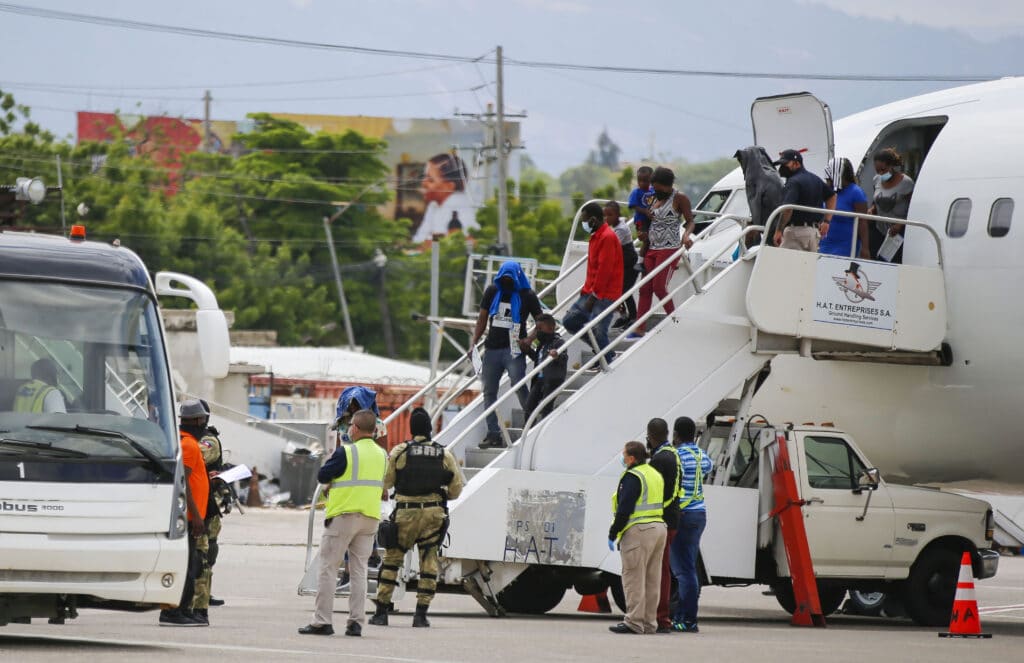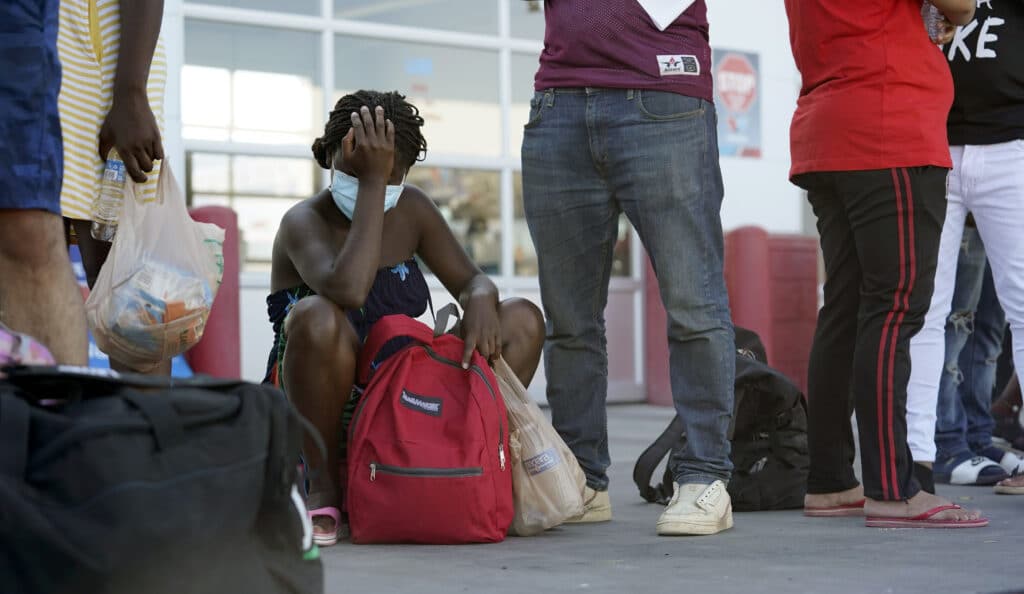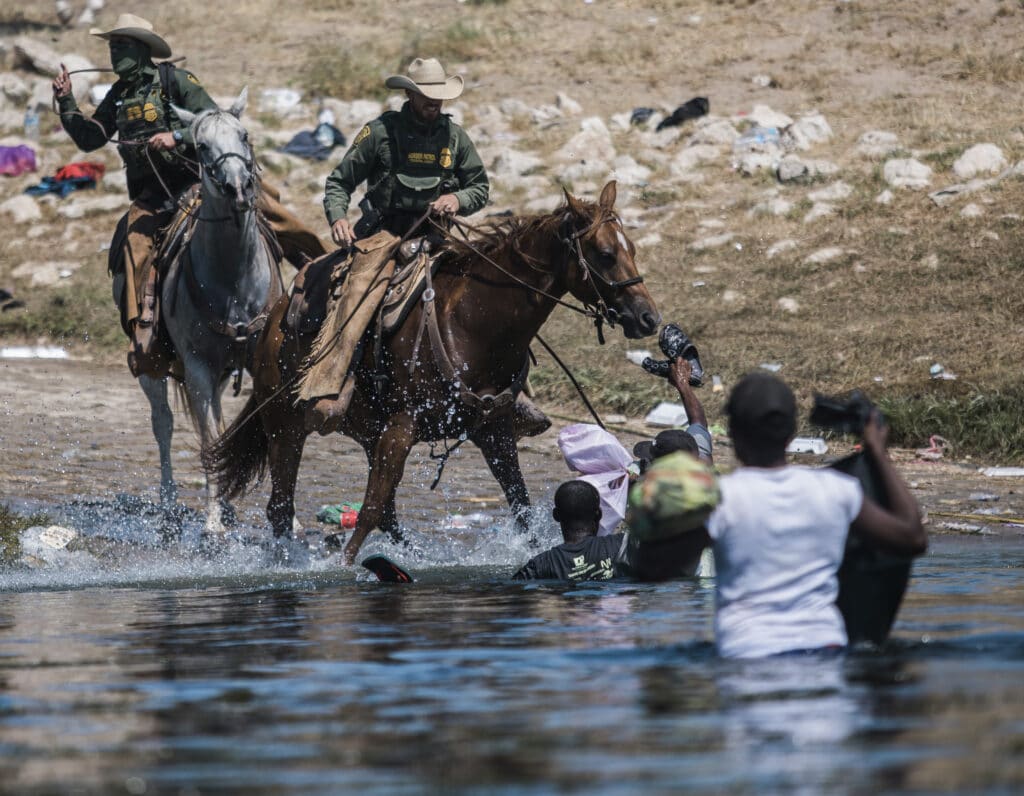After over 6,000 Haitians crossed the U.S. border from Mexico into Texas, the Biden administration took swift action deporting them all. This came under criticism since the Biden administration said it would be taking a different approach to illegal immigration than the Trump administration. The Associated Press has the story:
‘If you come to the United States illegally, you will be returned’
DEL RIO, Texas (AP) — More than 6,000 Haitians and other migrants have been removed from an encampment at a Texas border town, U.S. officials said Monday as they defended a strong response that included immediately expelling migrants to their impoverished Caribbean country and faced criticism for using horse patrols to stop them from entering the town.
Calling it a “challenging and heartbreaking situation,” Department of Homeland Security Secretary Alejandro Mayorkas issued a stark warning: “If you come to the United States illegally, you will be returned. Your journey will not succeed, and you will be endangering your life and your family’s life.”

Isaac Isner, 30, and his wife Mirdege, took wet clothing off their 3-year-old daughter Isadora after crossing the Rio Grande to Ciudad Acuña, Mexico, Monday afternoon. They had been in Del Rio, Texas, for seven days but decided to return to Mexico after a friend showed cellphone video of the U.S. expelling migrants.
“They were putting people on a bus and sent them to Haiti just like that without signing anything,” Isner said.
His family has an appointment this month with Mexico’s asylum agency in the southern city of Tapachula, and they think they could be safe in Mexico.
Most migrants, however, still haven’t made up their minds.
“We don’t know what we’re going to do,” said a second Haitian man, who declined to give his name but said he crossed into Mexico Monday for food, leaving his wife and child in Del Rio. “The U.S. is deporting and now Mexico won’t just sit back and do nothing. We don’t know where to go.”

Marcelo Ebrard, Mexico’s foreign minister, said about 15% of the Haitian migrants in Mexico have accepted refuge there. So far this year, about 19,000 Haitian migrants have requested asylum in Mexico.
“Mexico does not have any problem with them being in our country as long as they respect Mexico’s laws,” he said.
Mexico was busing Haitian migrants from Ciudad Acuña Sunday evening, according to Luis Angel Urraza, president of the local chamber of commerce. Mexico’s immigration agency did not immediately respond to a request for comment. But a federal official told The Associated Press on Sunday that the plan was to take the migrants to Monterrey, in northern Mexico, and Tapachula, in the south, with flights to Haiti from those cities to begin in coming days.
Mayorkas and U.S. Border Patrol Chief Raul Ortiz said they would look into agents on horseback using what appeared to be whips and their horses to push back migrants at the river between Ciudad Acuña and Del Rio, a city of about 35,000 people roughly 145 miles (230 kilometers) west of San Antonio where thousands of migrants remain camped around a bridge.

Both officials said during an afternoon news conference they saw nothing apparently wrong based on the widely seen photos and video. Mayorkas said agents use long reins, not whips, to control their horses. Ortiz, the former chief of the Del Rio sector, said it can be confusing to distinguish between migrants and smugglers as people move back and forth near the river. The chief said he would investigate to make sure there was no “unacceptable” actions by the agents.
“I don’t think anyone seeing that footage would think it acceptable or appropriate,” White House press secretary Jen Psaki said when asked about the images at a nearly simultaneous briefing. She deemed the footage “horrific” and said the matter would be investigated.
Later Monday, the Department of Homeland Security issued a statement calling the footage “extremely troubling” and promising a full investigation that would “define the appropriate disciplinary actions to be taken.”
Mayorkas said 600 Homeland Security employees, including from the Coast Guard, have been brought to Del Rio. He said he has asked the Defense Department for help in what may be one of the swiftest, large-scale expulsions of migrants and refugees from the United States in decades.

He also said the U.S. would increase the pace and capacity of flights to Haiti and other countries in the hemisphere. The number of migrants at the bridge peaked at 14,872 on Saturday, said Brandon Judd, president of the National Border Patrol Council, a labor union that represents agents.
“When it was reported that were flights going back to Haiti, it got around almost immediately,” he said. “There has been talk that some of them are going to go back (to Mexico) but we have not seen very much movement.”
The rapid expulsions were made possible by a pandemic-related authority adopted by former President Donald Trump in March 2020 that allows for migrants to be immediately removed from the country without an opportunity to seek asylum. President Joe Biden exempted unaccompanied children from the order but let the rest stand.
Any Haitians not expelled are subject to immigration laws, which include rights to seek asylum and other forms of humanitarian protection. Families are quickly released in the U.S. because the government cannot generally hold children.

More than 320 migrants arrived in Port-au-Prince on three flights Sunday, and Haiti said six flights were expected Tuesday. The U.S. plans to begin seven expulsion flights daily on Wednesday, four to Port-au-Prince and three to Cap-Haitien, according to a U.S. official who was not authorized to discuss the matter publicly. Flights will continue to depart from San Antonio but authorities may add El Paso, the official said.
The only obvious parallel for such an expulsion without an opportunity to seek asylum was in 1992 when the Coast Guard intercepted Haitian refugees at sea, said Yael Schacher, senior U.S. advocate at Refugees International whose doctoral studies focused on the history of U.S. asylum law.
Similarly large numbers of Mexicans have been sent home during peak years of immigration but over land and not so suddenly.
Central Americans have also crossed the border in comparable numbers without being subject to mass expulsion, although Mexico has agreed to accept them from the U.S. under pandemic-related authority in effect since March 2020. Mexico does not accept expelled Haitians or people of other nationalities outside of Mexico, Guatemala, Honduras and El Salvador.
In Mexico, local authorities of border municipalities have asked for help from state and federal authorities. Claudio Bres, the mayor in Piedras Negras, about 62 miles (100 kilometers) southeast of Ciudad Acuña, told local media that the official agreement is to turn back all the buses with migrants to prevent them from reaching the border. He said that last weekend around 70 buses passed through his town.
Haitians have been migrating to the U.S. in large numbers from South America for several years, many having left their Caribbean nation after a devastating 2010 earthquake. After jobs dried up from the 2016 Summer Olympics in Rio de Janeiro, many made the dangerous trek by foot, bus and car to the U.S. border, including through the infamous Darien Gap, a Panamanian jungle.
Some of the migrants at the Del Rio camp said the recent devastating earthquake in Haiti and the assassination of President Jovenel Moïse make them afraid to return to a country that seems more unstable than when they left.

“In Haiti, there is no security,” said Fabricio Jean, a 38-year-old Haitian who arrived in Texas with his wife and two daughters. “The country is in a political crisis.”
But Mayorkas defended his recent decision to grant Haitians temporary legal status due to political and civil strife in their homeland if they were in the United States on July 29, but not to those being sent back now.
“We made an assessment based on the country conditions … that Haiti could in fact receive individuals safely,” he said.
Six flights were scheduled to Haiti on Tuesday — three to Port-au-Prince and three to the northern city of Cap-Haitien, said Jean Négot Bonheur Delva, Haiti’s migration director.
Some migrants said they were planning to leave Haiti again as soon as possible. Valeria Ternission, 29, said she and her husband want to travel with their 4-year-old son back to Chile, where she worked as a bakery’s cashier.
“I am truly worried, especially for the child,” she said. “I can’t do anything here.”
By JUAN A. LOZANO, ERIC GAY, ELLIOT SPAGAT and MARIA VERZA
Lozano and Verza reported from Ciudad Acuña, Mexico, and Spagat from San Diego. Associated Press writers Danica Coto in San Juan, Puerto Rico, Evens Sanon from Port-au-Prince, Haiti, and Tammy Webber in Fenton, Michigan, also contributed to this report.







